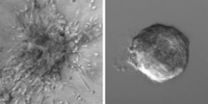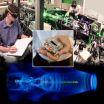(Press-News.org) Most big galaxies fit into one of two camps: pinwheel-shaped spiral galaxies and blobby elliptical galaxies. Spirals like the Milky Way are hip and happening places, with plenty of gas and dust to birth new stars. Ellipticals are like cosmic retirement villages, full of aging residents in the form of red giant stars. Now, astronomers have discovered that one well-known elliptical has a split personality. Centaurus A is hiding a gassy spiral in its center.
"No other elliptical galaxy is known to have spiral arms," said lead author Daniel Espada (National Astronomical Observatory of Japan & Harvard-Smithsonian Center for Astrophysics). "Centaurus A may be an old galaxy, but it's still very young at heart."
Centaurus A isn't your typical elliptical to begin with. Its most striking feature is a dark dust lane across its middle - a sign that it swallowed a spiral galaxy about 300 million years ago.
Centaurus A slurped that galaxy's gases down, forming a disk that we see nearly edge on. From our point of view, any features in that disk have been hidden by the intervening dust.
To tease out the disk's structure, Espada and his colleagues used the sharp vision of the Smithsonian's Submillimeter Array. This radio telescope can see through dust to pick up signals from naturally occurring carbon monoxide gas. By mapping the gas, the team unveiled two distinct spiral arms within the galaxy's core.
These gaseous tendrils have sizes and shapes similar to spiral arms in galaxies like the Milky Way. Also like the Milky Way's spiral arms, they are forming new generations of stars.
"Centaurus A has been given a new lease on life by that past merger," said Espada.
Computer simulations suggest that the spiral features might endure for hundreds of millions of years to come.
Although Centaurus A is the first elliptical galaxy found to have spiral arms, it may not be the last. Since it's only 12 million light-years away, it's relatively nearby and easy to study. The Atacama Large Millimeter/submillimeter Array (ALMA) potentially can find more split-personality galaxies with its improved radio "vision."
"We definitely will use ALMA to search for other objects that are similar to Centaurus A," added Espada.
### END
Split-personality elliptical galaxy holds a hidden spiral
2012-10-22
ELSE PRESS RELEASES FROM THIS DATE:
High quality or poor value: When do consumers make different conclusions about the same product?
2012-10-22
Depending on which naive theory consumers use, a low price can indicate either good value or low quality, whereas a high price may imply either poor value or high quality, according to a new study in the Journal of Consumer Research.
"Consumers rarely have complete information and use various strategies to fill the gaps in their knowledge as they consider and choose products. One of these strategies involves using naive theories: informal, common sense, explanations that consumers use to make sense of their environment. For example, consumers may believe that popular ...
Rewards programs: When do consumers compare experience over value?
2012-10-22
Consumers are often less satisfied when they buy or receive products that are easily counted because this makes them focus on value instead of experience, according to a new study in the Journal of Consumer Research.
"Numbers make us feel more certain of what is in front of us. When we count, we understand exactly how big, expensive, heavy, or old something is. But when we buy or receive products that are easily counted, we may be less satisfied," write authors Jingjing Ma and Neal J. Roese (both Kellogg School of Management, Northwestern University).
What happens when ...
Greater parental stress linked to children's obesity, fast food use and reduced physical activity
2012-10-22
Parents with a higher number of stressors in their lives are more likely to have obese children, according to a new study by pediatric researchers. Furthermore, when parents perceive themselves to be stressed, their children eat fast food more often, compared to children whose parents feel less stressed.
"Stress in parents may be an important risk factor for child obesity and related behaviors," said Elizabeth Prout-Parks, M.D., a physician nutrition specialist at The Children's Hospital of Philadelphia, who led a study published online today in the November issue of ...
Friendship 2.0: Teens' technology use promotes sense of belonging, identity
2012-10-22
With adolescents seemingly glued to cell phones and social networking websites, experts are investigating whether the near-constant digital activity changes youths' development.
A new study from the University of Washington shows that digital media helps teens reach developmental milestones, such as fostering a sense of belonging and sharing personal problems. But the study also raised questions about whether digital connectedness might hinder the development of an autonomous sense of self.
Katie Davis, an assistant professor in the Information School and an expert ...
Breast cancer cells enticed to spread by 'tumorous environment' as well as genetic changes
2012-10-22
A new study from Johns Hopkins researchers suggests that the lethal spread of breast cancer is as dependent on a tumor's protein-rich environment as on genetic changes inside tumor cells.
In a report in the Sept. 25 issue of the Proceedings of the National Academy of Sciences, the scientists conclude that a molecular signal in the protein meshwork surrounding the breast cancer cells may provide the critical trigger to initiate the life-threatening process of metastasis to distant sites in the body.
Moreover, their experiments suggest that the environment surrounding ...
Clue to cause of Alzheimer's dementia found in brain samples
2012-10-22
Researchers at Washington University School of Medicine in St. Louis have found a key difference in the brains of people with Alzheimer's disease and those who are cognitively normal but still have brain plaques that characterize this type of dementia.
"There is a very interesting group of people whose thinking and memory are normal, even late in life, yet their brains are full of amyloid beta plaques that appear to be identical to what's seen in Alzheimer's disease," says David L. Brody, MD, PhD, associate professor of neurology. "How this can occur is a tantalizing ...
State-of-the-art beams from table-top accelerators
2012-10-22
Focusing in on beam focus
The rapidly evolving technology of laser plasma accelerators (LPAs) – called "table-top accelerators" because their length can be measured in centimeters instead of kilometers – promises a new breed of machines, far less expensive and with far less impact on the land and the environment than today's conventional accelerators.
Future LPAs offer not only compact high-energy colliders for fundamental physics but diminutive light sources as well. These will probe chemical reactions, from artificial photosynthesis to "green catalysis"; unique biological ...
Scattered X-rays reveal diseased tissue
2012-10-22
This press release is available in German.
Chronic obstructive pulmonary disease (COPD) is considered the fourth most common cause of death in the United States. Usually the precursor to this life-threatening lung disease is a chronic bronchitis. Partially destroyed alveoli and an over-inflation of the lungs, known as emphysema, are serious side effects. However, the subtle differences in the tissue are barely discernable in standard X-ray images.
In addition to the conventional X-ray images, the Munich scientists analyzed the radiation scattered by the tissue. ...
Fewer patient deaths after surgery in hospitals known for good nursing care
2012-10-22
Patients treated in magnet hospitals (specially designated for their nursing excellence) had 14 percent lower odds of death than those in non-magnet hospitals in a four-state study of 564 hospitals led by the University of Pennsylvania School of Nursing. The magnet designation, determined by the American Nurses Credentialing Center, recognizes high-quality patient care, high levels of nurse education, and nursing innovation.
"Even controlling for differences in nursing, hospital, and patient characteristics, surgical patients fared better in magnet hospitals," said lead ...
Energy-sensing switch discovery could have broad implications for Biology & Medicine
2012-10-22
LA JOLLA, CA – October 21, 2012 – Biochemists at The Scripps Research Institute (TSRI) have discovered a genetic sequence that can alter its host gene's activity in response to cellular energy levels. The scientists have found this particular energy-sensing switch in bacterial genes, which could make it a target for a powerful new class of antibiotics. If similar energy-sensing switches are also identified for human genes, they may be useful for treating metabolism-related disorders such as type 2 diabetes and heart disease.
"This discovery adds a new dimension to our ...



